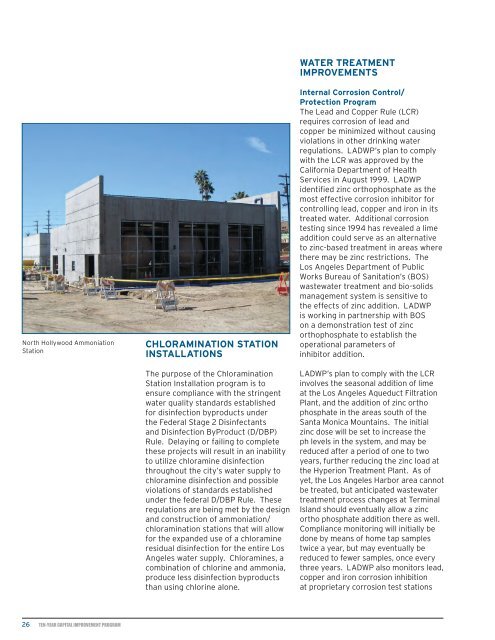TEN-YEAR CAPITAL IMPROVEMENT PROGRAM - LA Differentiated
TEN-YEAR CAPITAL IMPROVEMENT PROGRAM - LA Differentiated
TEN-YEAR CAPITAL IMPROVEMENT PROGRAM - LA Differentiated
Create successful ePaper yourself
Turn your PDF publications into a flip-book with our unique Google optimized e-Paper software.
North Hollywood Ammoniation<br />
Station<br />
CHLORAMINATION STATION<br />
INSTAL<strong>LA</strong>TIONS<br />
The purpose of the Chloramination<br />
Station Installation program is to<br />
ensure compliance with the stringent<br />
water quality standards established<br />
for disinfection byproducts under<br />
the Federal Stage 2 Disinfectants<br />
and Disinfection ByProduct (D/DBP)<br />
Rule. Delaying or failing to complete<br />
these projects will result in an inability<br />
to utilize chloramine disinfection<br />
throughout the city’s water supply to<br />
chloramine disinfection and possible<br />
violations of standards established<br />
under the federal D/DBP Rule. These<br />
regulations are being met by the design<br />
and construction of ammoniation/<br />
chloramination stations that will allow<br />
for the expanded use of a chloramine<br />
residual disinfection for the entire Los<br />
Angeles water supply. Chloramines, a<br />
combination of chlorine and ammonia,<br />
produce less disinfection byproducts<br />
than using chlorine alone.<br />
WATER TREATMENT<br />
<strong>IMPROVEMENT</strong>S<br />
Internal Corrosion Control/<br />
Protection Program<br />
The Lead and Copper Rule (LCR)<br />
requires corrosion of lead and<br />
copper be minimized without causing<br />
violations in other drinking water<br />
regulations. <strong>LA</strong>DWP’s plan to comply<br />
with the LCR was approved by the<br />
California Department of Health<br />
Services in August 1999. <strong>LA</strong>DWP<br />
identified zinc orthophosphate as the<br />
most effective corrosion inhibitor for<br />
controlling lead, copper and iron in its<br />
treated water. Additional corrosion<br />
testing since 1994 has revealed a lime<br />
addition could serve as an alternative<br />
to zinc-based treatment in areas where<br />
there may be zinc restrictions. The<br />
Los Angeles Department of Public<br />
Works Bureau of Sanitation’s (BOS)<br />
wastewater treatment and bio-solids<br />
management system is sensitive to<br />
the effects of zinc addition. <strong>LA</strong>DWP<br />
is working in partnership with BOS<br />
on a demonstration test of zinc<br />
orthophosphate to establish the<br />
operational parameters of<br />
inhibitor addition.<br />
<strong>LA</strong>DWP’s plan to comply with the LCR<br />
involves the seasonal addition of lime<br />
at the Los Angeles Aqueduct Filtration<br />
Plant, and the addition of zinc ortho<br />
phosphate in the areas south of the<br />
Santa Monica Mountains. The initial<br />
zinc dose will be set to increase the<br />
ph levels in the system, and may be<br />
reduced after a period of one to two<br />
years, further reducing the zinc load at<br />
the Hyperion Treatment Plant. As of<br />
yet, the Los Angeles Harbor area cannot<br />
be treated, but anticipated wastewater<br />
treatment process changes at Terminal<br />
Island should eventually allow a zinc<br />
ortho phosphate addition there as well.<br />
Compliance monitoring will initially be<br />
done by means of home tap samples<br />
twice a year, but may eventually be<br />
reduced to fewer samples, once every<br />
three years. <strong>LA</strong>DWP also monitors lead,<br />
copper and iron corrosion inhibition<br />
at proprietary corrosion test stations<br />
26<br />
<strong>TEN</strong>-<strong>YEAR</strong> <strong>CAPITAL</strong> <strong>IMPROVEMENT</strong> <strong>PROGRAM</strong>





